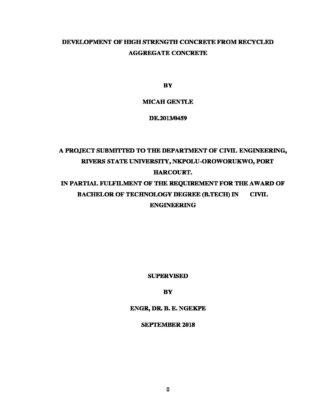Description
INTRODUCTION
Nigeria has experienced flooding attacks in diverse places and levels within the last two decades. In 2001, for instance, Abia, Adamawa and Akwa-Ibom States witnessed heavy downpour and rainstorm which affected about 5,000 people. In the same year, about 12,300 persons were displaced by torrential rain that resulted to flooding that destroyed farmlands, damaged properties and submerged buildings in Zamfara State. In 1988 and 2001, Kano witnessed windstorm and flood that affected 300,000. What with the 2011 Lagos and Ibadan floods that wreaked extensive havoc.(Ajayi, Ola 2012)
Similarly in 1999 and 2001, Bayelsa and Delta States experienced heavy floods that rendered hundreds of people homeless. In 2005, it affected Taraba State as massive flood displaced over 50,000 persons. And then, in August and early September 2007, heavy rainfall led to severe flooding in several West African countries such as Nigeria, Ghana, Burkina Faso, Mali, Kenya Togo, killing 353 and affecting over 600,000 persons. It becomes clear that the flood menace is not strange to Nigeria after all. (Punch 2015)
Soil is defined as the thin layer of the earth surface that can hold anything on its surface and also have the ability to support. In a very broad sense, soil refers to all unconsolidated materials at the earth’s surface that is capable of supporting life (Ogundimu, 2005)
Soil is a mixture of minerals, organic matter, gases, liquids, and countless organisms that work together to support life on Earth. Soil is a natural body called the pedosphere which has four important functions: it is a medium for plant growth; it is a means of water storage, transport, supply and purification; it is a modifier of Earth’s atmosphere; it is a habitat for organisms; all of which, in turn, modify the soil. Soil is called the “Skin of the Earth” and interfaces with its lithosphere, hydrosphere, atmosphere, and biosphere (Montgomery 2003)
The physical properties of soil are texture, structure, density, porosity, consistency, temperature, colour and resistivity. Of all the factors influencing the evolution of soil, water is the most powerful due to its involvement in the solution, erosion, transportation, and deposition of the materials of which a soil is composed. (Strahler, 1971)
Flood is defined as extremely high flow of river, whereby water inundates flood plains or terrains outside the water confinement of major river channels. Flood hazard is measured by possibility of occurrence of their damaging consequences, conceived generally as flood risk or by their impact on society conceived usually as the loss of lives and material damage to society. Flood is a natural occurrence, yet, its impact can be controlled by man. It becomes a problem when people are not prepared for it and early warning prognosis are flagrantly ignored while mitigation measures are not put in place to attenuate its impact on the economy. (Oriola, 2000) Floods occur when water particularly from rainfalls accumulates across an impermeable surface and cannot rapidly dissipate or evaporate. Floods can also be caused by a series of storms moving over the same area. Even dams can flood low-lying areas, often causing significant damages
Nationally Anambra State is aflood prone zone which includes Awka excluding few parts. The flood hazard of year 2012 was unprecedented in Nigeria and was seen as a national disaster. 94% of states of the Federation including Anambra State suffered great losses in the flood. 38% of local government areas in Anambra State including Awka south local government area were adversely affected. Houses and other public and private properties, infrastructure and facilities were submerged and destroyed while many residents were displaced (SEMA, 2012). The essence of this study is to ascertain the place of soil characteristics in the incessant flooding in Awka.
CHAPTER ONE
Introduction
1.1 Background of study
1.2 Aim and Objectives
1.4 Research Questions
1.5 Research Hypothesis
1.6 Scope of Study
1.7 Limitations of Study
1.8 Study Area
1.8.1 Brief History
1.8.2 Location and Extent
1.8.3 Climate
1.8.4 Geology
1.8.5 Soil
1.8.6 Topography
1.8.7 Human and Economic Activity
1.9 Conceptual Framework
1.9.1 The Concept of Hydrologic Cycle
1.10 Plan of Study
1.11 Significance of Study
CHAPTER TWO
Literature Review
Introduction
2.1.2 Topographic and Geologic factors
2.1.3 High Precipitation Rate
2.1.4 Dam Failure
2.1.5 Human Activities
2.2 Effects Of Flood
2.2.1 Impacts on the Economic and Agricultural Activity
2.2.2 Environmental Degradation
2.2.3 Loss of Life
2.2.4 Displacement Of People.
2.2.5 Impact On Soil
2.3 Flood Control Measures
2.4 Synthesis of literature
2.5 Gaps in literature
2.6 Justification of the Work
CHAPTER THREE
Research Methodology
3.1 Research Design
3.2 Research Needs
3.3 Types and Sources of Data
3.4 Method of Data Collection
3.4.1 Field observation
3.5 Method of Data Analysis
3.5.1 Sample Analysis
3.6 Method of Statistical Analysis
CHAPTER FOUR
Data Presentation, Discussion Of Findings and Hypothesis Testing
4.1 Data Presentation and Analyses
4.1.1 Physical Characteristics of the Soils
4.1.2 Geotechnical Characteristics of the Soils
4.2 Hypothesis Testing
Hypothesis One
CHAPTER FIVE
Summary, Conclusions and Recommendations
5.1 Summary
5.2 Conclusion
5.3 Recommendation
Reference
